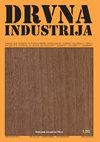Characterization and Separation of Lignin from Kraft Black Liquor with Different Alcohols
IF 0.8
4区 农林科学
Q4 MATERIALS SCIENCE, PAPER & WOOD
引用次数: 0
Abstract
The aim of this study was to investigate the properties of lignin obtained from black liquors of Scots pine (Pinus sylvestris L.) and European aspen (Populus tremula L.) woods cooked by Kraft method. In the study, the cooking process was carried out according to parameters such as: 1/4 of wood/liquor ratio, cooking temperature at (170±2) °C, and cooking time of 90 min. After the cooking process, the black liquor was taken to a beaker from the digester, and lignin was recovered in different ways from the black liquor with methyl alcohol (MeOH) and ethyl alcohol (EtOH). The material properties of the recovered lignin were analyzed by scanning electron microscopy (SEM), Fourier transform infrared spectroscopy (FT-IR), x-ray diffraction (XRD), and thermogravimetric analysis (TGA). Commercial lignin (cml-lignin) was used to compare the properties of lignin obtained from black liquor. SEM images showed that the particle sizes of lignin obtained with EtOH and MeOH were similar. In FT-IR, it was detected that the recovered lignin types have similar functional groups, while some differences were observed in intensities of the peaks. XRD results revealed that all lignin types were found to have a similar structure with the cml-lignin, and that alcohol types used during the recovery process of lignin do not have an important effect on the structural properties of lignin. The TGA results indicated that the thermal stability of recovered lignin has better thermal stability than cml-lignin. The results showed that the recovered lignin was similar to commercial lignin and that it can be recovered from the liquor leftover from Kraft pulping by the method described and used in industry.不同醇类硫酸盐黑液中木质素的表征与分离
本研究的目的是研究用硫酸盐法蒸煮的苏格兰松(Pinus sylvestris L.)和欧洲白杨(Populus tremula L.)黑液中木质素的性质。在本研究中,蒸煮过程根据以下参数进行:木材/液体比例的1/4,蒸煮温度为(170±2)°C,蒸煮时间为90min。蒸煮过程结束后,将黑液从蒸煮器中放入烧杯中,用甲醇(MeOH)和乙醇(EtOH)以不同的方式从黑液中回收木质素。通过扫描电子显微镜(SEM)、傅立叶变换红外光谱(FT-IR)、x射线衍射(XRD)和热重分析(TGA)对回收木质素的材料性能进行了分析。利用商品木质素(cml木质素)对黑液中木质素的性质进行了比较。SEM图像显示,用EtOH和MeOH获得的木质素的粒度相似。在FT-IR中,检测到回收的木质素类型具有相似的官能团,但在峰的强度上观察到一些差异。XRD结果表明,所有类型的木质素都与cml木质素具有相似的结构,并且在木质素回收过程中使用的醇类型对木质素的结构性能没有重要影响。TGA结果表明,回收木质素的热稳定性优于cml木质素。结果表明,回收的木质素与商业木质素相似,可以用所述方法从硫酸盐法制浆废液中回收并在工业上使用。
本文章由计算机程序翻译,如有差异,请以英文原文为准。
求助全文
约1分钟内获得全文
求助全文
来源期刊

Drvna Industrija
MATERIALS SCIENCE, PAPER & WOOD-
CiteScore
1.80
自引率
9.10%
发文量
32
审稿时长
>12 weeks
期刊介绍:
"Drvna industrija" ("Wood Industry") journal publishes original scientific and review papers, short notes, professional papers, conference papers, reports, professional information, bibliographical and survey articles and general notes relating to the forestry exploitation, biology, chemistry, physics and technology of wood, pulp and paper and wood components, including production, management and marketing aspects in the woodworking industry.
 求助内容:
求助内容: 应助结果提醒方式:
应助结果提醒方式:


